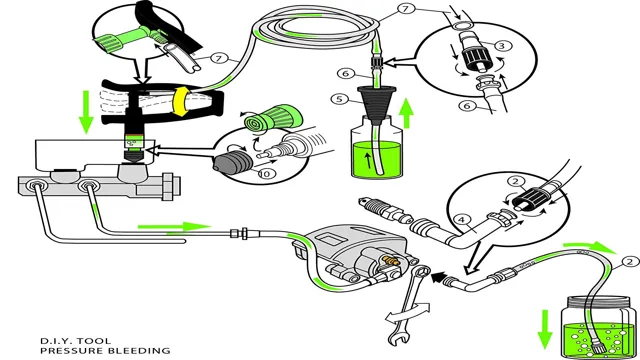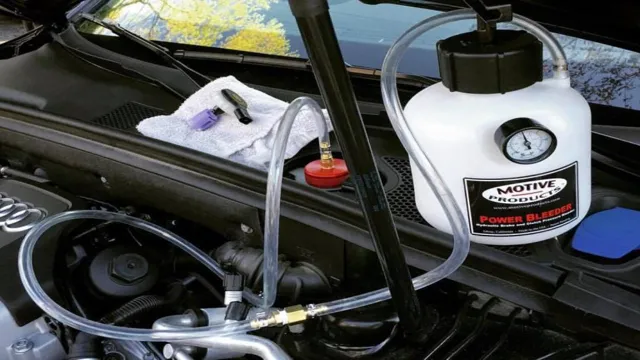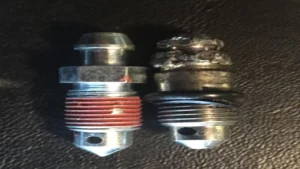Have you ever wondered how power brake bleeders work and why they’re essential for your car’s braking system? Brake bleeding is the process of removing air bubbles from your brake lines, which can compromise the effectiveness of your brakes. While traditional brake bleeding methods require a second person to depress the brake pedal, power brake bleeders are a one-man operation that uses a pressurized reservoir to force air out of the system. Think of it like a balloon inflator, but for your brakes.
In this blog, we’ll dive into the nitty-gritty of how power brake bleeders work, why they’re necessary, and how to use them properly to keep your braking system in top shape.
What are Power Brake Bleeders?
Power brake bleeders are tools that help to remove air bubbles from your car’s brake lines, ensuring that your brakes function properly. This is done by attaching the power brake bleeder to the brake fluid reservoir and pressurizing the system with the help of an electric pump. The increased pressure forces the brake fluid through the brake lines and calipers, pushing any air out of the system.
This is different from the traditional method of using the brake pedal to pump out the air. With power brake bleeders, you can work alone and do not require the assistance of another person to work the brake pedal. This makes it easier and more efficient to get the job done.
Additionally, power brake bleeders are a great investment for anyone who wants to save money on costly repairs, as properly maintained brake systems can prevent many expensive repairs down the line.
Definition and Purpose
Power Brake Bleeders are a tool used for automotive maintenance that simplifies the brake bleeding process. They work by pressurizing the brake system and forcing air bubbles out, resulting in a more efficient and effective brake system. These devices can also save time and effort compared to traditional brake bleeding methods, which require two people and can take a lot of trial and error to get right.
Power Brake Bleeders come in various sizes and shapes, with different adapters to fit different types of vehicles. They are a valuable investment for any DIY mechanic or professional auto technician looking to save time and ensure a safer driving experience for themselves and their clients. With regular use, a Power Brake Bleeder can help keep your brake system in good working condition, prevent costly repairs, and provide peace of mind on the road.

Types of Power Brake Bleeders
A power brake bleeder is a tool used to remove air from the brake system, ensuring optimal braking performance. There are different types of power brake bleeders available, including gravity-fed, hand pump, and air compressor-powered. A gravity-fed brake bleeder relies on gravity to force the brake fluid into the system, while a hand pump brake bleeder requires a manual pumping action to generate pressure.
An air compressor-powered brake bleeder uses a compressor to generate pressure, which is then used to bleed the brakes. Regardless of the type of power brake bleeder used, they all work by pressurizing the brake system, forcing the air out and allowing the fluid to enter. The process involves attaching the bleeder to the brake system and releasing the pressure valve, allowing the brake fluid to flush through the system until all air is removed.
Overall, power brake bleeders are essential tools for maintaining safe and reliable vehicle braking systems, ensuring maximum performance when it matters most.
Vacuum Bleeder
When it comes to power brake bleeders, the vacuum bleeder stands out as an efficient tool for car owners and mechanics. It uses a vacuum pump to suck the brake fluid out of the brake lines and into a reservoir, which eliminates the need for manual pressure during the bleeding process. The vacuum bleeder also prevents air bubbles from entering the brake lines, ensuring that the system is free from any air pockets.
There are two types of vacuum bleeders: hand-held and pressure bleeders. Hand-held vacuum bleeders are manual tools that require an individual to create the vacuum by pumping a handle, while pressure bleeders use a pressurized tank to force the brake fluid through the lines. Both types have their benefits and drawbacks, and the choice ultimately comes down to personal preference and the specific needs of the vehicle.
So, whether you’re a DIYer or professional mechanic, a vacuum bleeder is an excellent investment that can save time and ensure a safe and efficient brake system.
Pressure Bleeder
Pressure Bleeder When it comes to brake bleeders, there are two main types available – manual and power. Power brake bleeders use either pressure or vacuum to flush the brake lines, while manual bleeders require the user to pump the brake pedal manually. Today, let’s focus on the pressure brake bleeders.
Pressure bleeders apply pressure to the brake fluid, forcing it through the brake lines and out of the system. This method of bleeding is generally faster and more efficient than manual bleeding. The pressure bleeder is connected to the brake fluid reservoir and pressurized with air.
This pressure allows the brake fluid to flow from the reservoir through the system, expelling any air pockets or old, contaminated fluid. However, it is essential to make sure the pressure bleeder is properly attached and secured before pressurizing to avoid any potential accidents. A pressure bleeder is an efficient tool for brake service professionals looking to quickly and easily bleed brakes.
How Power Brake Bleeders Work
Have you ever wondered how a power brake bleeder works? Well, wonder no more! A power brake bleeder is a device that helps you flush out old or contaminated brake fluid from your vehicle’s brake system. It works by utilizing a pressurized tank that is attached to the vehicle’s brake lines. The tank is then filled with fresh brake fluid, and the pressurized air in the tank forces the old fluid out of the system through the brake lines.
This process can be completed quickly and efficiently, and it ensures that the brake system is free from any contaminants that could affect its performance. Plus, using a power brake bleeder eliminates the need for a second person to help you bleed your brakes, making it a one-person job that can be done with ease. So, if you’re looking for an easy and efficient way to maintain your vehicle’s brake system, a power brake bleeder is the way to go!
Step-by-Step Process
A power brake bleeder is a tool used to remove air bubbles from the brake lines in your car’s braking system. This process is important because air in the brake lines can reduce the effectiveness of your brakes and lead to unsafe driving conditions. The power brake bleeder works by using a vacuum to suck the air out of the brake lines.
First, the power bleeder is connected to the master cylinder. Next, the bleeder valve on each brake caliper is opened and the brake fluid is allowed to flow through the system while a vacuum is applied to remove any air bubbles. This process continues until all the air is removed from the brake lines.
Once completed, the bleeder valves are closed and the brake system is then refilled with new brake fluid. Using a power brake bleeder is an efficient and effective way to ensure that your brakes are working properly and help ensure your safety on the road. So, invest in a power brake bleeder today and maintain your car’s brakes for smooth and safe driving.
Benefits of Using a Power Brake Bleeder
Power brake bleeders offer numerous benefits over traditional methods. They use a combination of pressure and vacuum to purge air from brake lines and achieve a more thorough and efficient bleed. With a power brake bleeder, you can quickly and easily remove air from all parts of the brake system, including the master cylinder, wheel cylinders, and calipers.
The process saves time and effort as you can complete the bleed in less time than with traditional methods. The use of a power brake bleeder also reduces the risk of contamination as there is no need to open the brake system to expose it to air. Furthermore, the pressure gauge on the power brake bleeder allows you to monitor the pressure and avoid over-bleeding.
In summary, power brake bleeders are highly effective and can make the brake bleed process much more straightforward, quicker, and less prone to contamination.
Tips for Using a Power Brake Bleeder
Power brake bleeders are an essential tool for maintaining your vehicle’s braking system, and understanding how they work can help you get the best results. Essentially, a power brake bleeder works by using pressurized air to force brake fluid through the system, eliminating any air bubbles that may have accumulated over time. By removing these bubbles, your brakes will function more smoothly and efficiently, improving performance and safety.
To get the most out of your power brake bleeder, it’s essential to follow some key tips, such as ensuring that your brake fluid is at the proper level, avoiding over-pressurization, and always using safety gear to protect yourself from potential hazards. With the right approach, using a power brake bleeder can be a quick and easy process that helps keep your brakes in top condition. Whether you are a novice or experienced mechanic, taking the time to learn about power brake bleeders is an investment in your vehicle’s longevity and your overall safety on the road.
Safety Precautions
When it comes to using a power brake bleeder, one of the most important things to keep in mind is safety. Before starting any work, it’s crucial to read the instruction manual and make sure you understand how to use the tool properly. Always wear protective equipment such as eye goggles and gloves.
It’s also important to ensure that the bleeder is securely and properly attached to the brake fluid reservoir. This will prevent any potential accidents that may occur due to the pressurizing of brake bleeders. Additionally, make sure to release any pressure from the bleeder before attempting to remove it from the reservoir.
This will avoid any possibility of fluid expelled accidents. With these safety precautions in mind, you can enjoy a trouble-free experience using a power brake bleeder to keep your vehicle in top condition.
Maintenance
Maintaining and bleeding your brakes is an essential part of keeping your vehicle in top condition and ensuring your safety on the road. That’s where a power brake bleeder comes in handy. To start, make sure you have the right equipment, including a power brake bleeder, brake fluid, and a wrench.
To use the power brake bleeder, connect it to your car’s brake fluid reservoir and pump it until you hear a hiss. Then, open the bleeder valve on each brake caliper, working from the wheel furthest away from the reservoir to the one closest to it. Finally, make sure you check the brake fluid level throughout the process and add more fluid as necessary.
With these simple tips and the right equipment, you can easily and quickly bleed your brakes and maintain your vehicle’s safety standards. Don’t forget to use DOT 3 or 4 brake fluid, and make sure you dispose of any fluids and old parts properly.
Conclusion
In short, a power brake bleeder is like a superhero for your brakes, able to quickly and efficiently remove any trapped air or contaminants that can cause issues down the road. Using the power of pressurized air, this tool creates a powerful vacuum that sucks out any unwanted elements and leaves your brakes feeling fresh and powerful. So next time your braking system needs a little TLC, remember the power brake bleeder and give your car the hero it deserves.
“
FAQs
What is a power brake bleeder?
A power brake bleeder is a tool that helps to remove air from the brake line by applying pressure to the brake fluid reservoir.
How does a power brake bleeder work?
A power brake bleeder works by attaching a hose to the brake fluid reservoir and applying pressure to it using either a hand pump or an air compressor. This pressure forces the brake fluid through the brake system, pushing any air bubbles out through the brake lines.
Can I use a power brake bleeder on my car?
Yes, you can use a power brake bleeder on most cars. However, it is important to check the manufacturer’s recommendation for your specific vehicle to ensure that it is compatible.
Do I need any special tools to use a power brake bleeder?
No, a power brake bleeder typically comes with all the necessary attachments and hoses to connect to the brake fluid reservoir. However, you may need an air compressor if you opt for an air-powered bleeder.
How long does it take to bleed brakes using a power brake bleeder?
The duration of brake bleeding using a power brake bleeder varies depending on the size of your vehicle, the brake system’s design, and the amount of air in the brake lines. Generally, it takes around 20-30 minutes per wheel.
Is it better to use a power brake bleeder or a traditional manual brake bleeding technique?
A power brake bleeder is generally considered a faster and more efficient way of bleeding brakes than the traditional manual technique. However, both methods can be effective if done correctly.
How often should I bleed my brakes using a power brake bleeder?
It is recommended to bleed brakes every year or so and more often if you experience spongy brakes or braking difficulties. However, the frequency varies depending on the car and the driving conditions.






